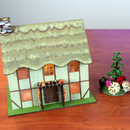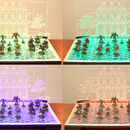Introduction: How to Design and Laser Cut Custom Game Tokens
In this tutorial I show how to create illustrations of game tokens using Adobe Illustrator, and then how to cut those tokens on a laser cutter. I show some tips on finishing, different types of acrylic and what works best for me.
Step 1: Tools and Materials
Tools:
Access to a laser cutter (I use one at my maker-space TechShop)
Design software (I use Adobe Illustrator)
Photo editing software (optional, I use Adobe Photoshop)
Materials:
Sheet acrylic (I prefer 3/16" continuous cast acrylic)
Simple Green cleaner (for removing paper)
Step 2: Collect Clip Art and Reference Photos
The first step in my design process is to gather up my visual references.
If I think I will need to utilize clip art, I find free clip art that is suitable, or if necessary I purchase a license to use it. In this example, I am making game tokens for Netrunner, so I looked for some high tech imagery to have available as an asset.
I was interested in one particular component of the high tech clip art - the circular bands, which will work well on several of my game tokens. Since this was already a vector drawing I could skip the image trace step and go directly to modification. I simplified the graphic by deleting many of the smaller bands and spacing the others further apart. Then I removed the fill color and turned the lines to RGB blue, which is the engraving color on my laser cutter.
I also use photographic references. For these game tokens I took a picture of my actual Netrunner tokens and cut them into separate images using Photoshop.
Step 3: Drawing Simple Designs
I start by creating a drawing that is just slightly larger than the size of the finished token, in this case 1.5" by 1.5".
I prefer to create shapes by clicking on the drawing and entering the dimensions. For the token I used the ellipse shape and made it 1.4" by 1.4".
When you are reproducing a photo reference, however, it is sometimes easier to just draw the shapes. In that case, holding the Alt key and drawing out from the center is usually the easiest way to draw circles.
The alignment tools are critical for any drawing exercise, and for tokens, selecting multiple circles and aligning the centers vertically and horizontally will give you concentric circles.
I used the pen tool to click on the vertices of my small rectangular shapes. Then I copied and pasted that shape, sometimes rotating it to fit in other positions.
Each step along the way I make sure the engraving lines are RGB blue and the cutting lines are RGB red, the recognized cutting color for my laser cutter.
Step 4: Drawing More Complex Designs
You can use text in a drawing, but you will need to convert it to vectors to engrave or cut it on a laser cutter. You can do this by selecting Type > Create Outlines, but do so only after you are completely happy with the text because it will become non-editable by the type editor once it is converted. After conversion, I remove the fill and make the line red, because I want to cut the "5" out of the center of my token.
Another powerful drawing tool is the Pathfinder, which I use extensively. In this little example, I selected a circle and the four rectangles and picked the "unite" option. You can play around with the different options, and don't be surprised if you don't get the result you are looking for on the first try! When using an option like "Minus Front", the arrangement of the layers is critical. You can quickly change the arrangement of objects by right-clicking on something and selecting Arrange > Bring To Front or Send To Back. Be prepared to experiment with the Pathfinder, it can have a steep learning curve, but it is worth the effort.
When you are finished, save your design in a format that is compatible with your laser cutter. I do all of my ongoing work in Illustrator CC, but save my final design in CS6 because that is what my laser cutter requires.
Step 5: Cut the Tokens on the Laser Cutter
Because I do all my engraving on the back of my tokens, for better visibility, I need to reverse my images before cutting. You can do this in Illustrator by selecting Object > Transform > Reflect on the vertical axis.
The design is for a single token, but of course you want to cut many copies, and you can do this easily by selecting the 'multiples' option on the laser cutter. You create a matrix of tokens by entering a number for the X dimension and a number for the Y dimension. You can even adjust the default spacing numbers, adjusting the density of the cuts, but I usually accept the defaults.
I remove the paper from the top of the acrylic sheet but always leave it on the back, to protect the tokens from smoke damage.
Sometimes, after cutting, I need to circle back to the design and refine it. In the fourth image I show the first and second iterations of a token, where the lines were too close together and didn't engrave cleanly. I went back and made the small rectangles slightly larger and spaced them out better, to get nice clean cuts.
I remove the paper by soaking my tokens in Simple Green for at least an hour and as long as a day. I pour the tokens out into a strainer and reuse the Simple Green for many batches. After soaking, the paper removes easily and I rinse the tokens by returning them to the strainer and holding them under running water.
Step 6: To Paint or Not to Paint?
I've tried many different painting techniques, and one thing I've learned for sure: if you are going to paint engraved acrylic, leave the paper on the engraved side! This is the only way to get neat results. The problem is, if you have painted them you cannot use the Simple Green method for paper removal, as it will also strip the paint as well. This means you have to peel everything by hand, which can be very difficult, especially on round tokens.
My preference on tokens is to not paint but do rear engraving. The second image shows a painted token next to a rear engraved token, and the engraved token is almost as readable and much easier to produce.
The third image shows two identical tokens, one rear engraved (on the left) and one top engraved. The rear engraved token is brighter and easier to see, but this particular token is a 'click' token that is turned over as a step in the turn is completed. For this application, I elected to go with top engraving so when the token was flipped the top side was smooth. Proof that the answer as to the best way to do anything is "it depends"... experimenting and decision making is all part of the design process. There are no hard and fast rules!
Step 7: The Best Acrylics for Tokens
I tried laminate sheets (image one) but I didn't like the results - I got smoke damage from the laser (maybe it would have been better to leave the paper on the top), the acrylic is too thin (1/16") and the back is always going to be a single solid color. In the end, I just prefer the jewel-like appearance of transparent acrylic!
The only colors I found that work for regular transparent acrylic are the yellow and orange shown in image two. All the other colors are too dark for rear engraving to show well.
The very best types of acrylic for tokens, in my opinion, are the fluorescent acrylics, shown in image three. They are sure-fired winners, with the orange and 'green' (it looks yellow) being the easiest to see.
As for thickness, the most common acrylic sheets are 1/8", but I prefer 3/16" for its satisfying chunkiness. I use 1/4" clear for certain special tokens, like my click counters, but I have lots of that laying around from other laser cutter projects and never need to buy it for this particular application.











